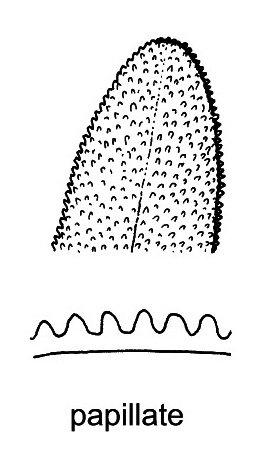|
|
 |
Key to PseudognaphaliumView taxon page for Pseudognaphalium
(For a list of species in Pseudognaphalium, use the above link.) Jepson Manual glossary definitions can be seen by moving your cursor over words underlined with dots. 1. Opposing leaf  Organ arising from a stem, generally composed of a stalk (petiole) and a flat, expanded, green, photosynthetic area (blade); distinguished from a leaflet by the presence in its axil of a bud, branch, thorn, or flower; sometimes with lateral, basal appendages (stipules); either simple (toothed, lobed, or dissected but not divided into leaflets) or compound (divided into leaflets). faces strongly to weakly contrasting in color, adaxial green, not tomentose  Covered with densely interwoven, generally matted hairs. (except Pseudognaphalium biolettii), sometimes glandular, abaxial generally gray to white, tomentose 2. Leaves crowded, internodes  Segment of an axis (generally a stem) between successive positions (nodes) from which one or more structures (especially leaves, buds, branches, or flowers) arise. 1–3(10) mm; leaf blade  Expanded portion of a leaf, petal, or other structure, generally flat but sometimes rolled, cylindric, wavy, or cupped. linear  Elongate, with nearly parallel sides; narrower than elliptic or oblong. to lance-linear, margin strongly rolled under; phyllaries bright white, opaque, dull; fruit ridged, smooth ..... P. leucocephalum 2' Leaves not crowded, internodes generally > 5 mm; leaf blade oblong  Longer than wide, with nearly parallel sides; wider than linear. or lanceolate  Narrowly elongate, widest in the basal half, often tapered to an acute tip. to oblanceolate (distal sometimes linear), flat or margin slightly curled under; phyllaries straw-colored to shiny white (± pink), opaque or transparent, dull or shiny; fruit papillate-roughened or ridged, smooth 3. Stem not glandular; leaf base not decurrent  Pertaining to a wing-like or ridge-like extension basal to the apparent or actual point of attachment, particularly a leaf base that appears to continue onto the stem. , clasping with ear-like basal  At or near the base of a plant or plant part. Especially said of leaves clustered near the ground or of a placenta confined to the base of an ovary. lobes  1. A major expansion or bulge, such as on the margin of a leaf, sepal, or petal, or on the surface of an ovary. 2. The free tips of otherwise fused structures, such as sepals or petals; larger than teeth. , opposing faces strongly contrasting in color ..... P. biolettii (2) 3' Stem stalked-glandular; leaf base decurrent, weakly to not clasping, opposing faces strongly to weakly contrasting in color ..... P. macounii 1' Opposing leaf faces not or weakly contrasting in color, both generally gray to gray-green or ± green, tomentose, adaxially sometimes glandular beneath long hairs 4. Leaf base ± clasping, decurrent 1–2 mm or not (decurrent 2–15 mm in Pseudognaphalium californicum) 5. Inflorescence a dense terminal cluster or ± open, cyme-like; involucre  Group of bracts more or less held together as a unit, subtending a flower, fruit (acorn cup), or inflorescence. 3–6 mm; phyllaries ± white, silver-gray to ± yellow or brown, transparent; pistillate flowers 135–200; pappus bristles loosely coherent, shed in clusters or easily fragmented rings 6. Involucre 3–4 mm; disk flowers 4–10; pistillate corolla red-tipped; fruit papillate  Pertaining to a surface (e.g., of a leaf, stigma, fruit) bearing small, rounded or conic protuberances (papillae). ..... P. luteoalbum 6' Involucre 4–6 mm; disk flowers generally 18–28; pistillate corolla evenly yellow; fruit glabrous ..... P. stramineum 5' Inflorescence ± flat-topped to panicle-like cluster; involucre 4–7 mm; phyllaries generally silvery white to white, sometimes pink, generally opaque; pistillate flowers 29–140; pappus bristles distinct, released singly 7. Stem stalked-glandular; abaxial leaf face generally green, stalked-glandular; phyllaries in 7–10 series ..... P. californicum (2) 7' Stem not glandular; abaxial leaf face generally white-tomentose or woolly-tomentose; phyllaries in 4–6 series 8. Annual or short-lived perennial  Completing life cycle (germination through death) in more than two years or growing seasons, generally non-woody (at least above ground) to woody; includes perennial herbs as well as subshrubs to trees; the abbreviation 'per' only refers to perennial herb, not to the word 'perennial' alone. herb; involucre 4–4.5 mm ..... P. roseum 8' Perennial herb; involucre 5–6 mm 4' Leaf base not ± clasping, decurrent or not 10. Leaf base not decurrent 11. Involucre 4–5 mm; phyllaries in 3–4 series; disk flowers (1)2–5(6); stem 2–3 mm diam near base; adaxial leaf face occasionally sessile-glandular beneath long hairs ..... P. canescens 11' Involucre 5–6 mm; phyllaries in 4–6 series; disk flowers 5–9; stem 3–5 mm diam near base; adaxial leaf face not glandular ..... P. microcephalum (2) 12' Stem and leaves stalked-glandular, glands sometimes obscured by nonglandular hairs 13' Leaf green or thinly gray-tomentose 14. Leaf generally narrowly lance-oblong, 5–10(20) mm wide; inflorescence flat-topped cluster; involucre bell-shaped to ± spheric when pressed; phyllaries in 7–10 series, white to pink ..... P. californicum (2) 14' Leaf linear to lanceolate, oblong, or narrowly spoon-shaped, 3–5(7) mm wide; inflorescence panicle-like cluster, generally elongate to widely columnar; involucre short-cylindric to top-shaped when pressed; phyllaries in 4–5 series, generally ± pink, sometimes white to ± green ..... P. ramosissimum
Please use this Google Form for Contact/Feedback
Citation for the whole project: Jepson Flora Project (eds.) . Jepson eFlora, https://ucjeps.berkeley.edu/eflora/ [accessed on ]
Citation for an individual treatment: [Author of taxon treatment] [year]. [Taxon name] in Jepson Flora Project (eds.) Jepson eFlora, [URL for treatment]. Accessed on .
We encourage links to these pages, but the content may not be downloaded for reposting, repackaging, redistributing, or sale in any form, without written permission from The Jepson Herbarium.
|
|
 |

